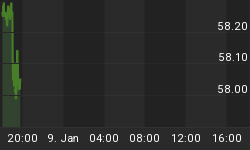The week of Feb. 7-11 was certainly rewarding to the patience of those who had the fortitude to ignore the bearish proclamations of the mainstream financial press against the South African gold industry. As we've indicated in two previous articles in recent weeks, the SA golds are far from dead and whenever the mainstream investment world gives up hope, a turnaround is usually right around the corner!
The SA mines have the distinction of being leaders in major gold stock bull markets due to their sensitivity to the price of gold and overall investment/political climate as it related to the yellow metal. I've observed that DRDGold (a.k.a., Durban Roodepoort Deep) has been a leading indicator for the XAU at major pivotal turning points over the last several years, and this is true in varying degrees with other South African mining shares as well.
In their book "How You Can Profit From Gold," authors James Sinclair and Harry Schultz offer the following assessment of the SA mining stocks:
"South African gold shares have always possessed a degree of sensitivity to the price performance of gold bullion. The connection is clear. The investor reasons correctly enough that high gold prices will be reflected in higher earnings and dividends by the mines, assuming consistent production schedules."
These authors also point out that the SA gold shares have a wide international following which makes them highly liquid and attractive as not only investment vehicles for riding precious metals bull markets, but also for short-term trading purposes.
Regarding our old friend DRDGold (DROOY), I recently received the following e-mail from a loyal reader: "The main reason that I bought into DROOY was the articles that you wrote in May and June 2001 telling people to buy at market. You explained the 'time wedges' that were near resolution in DROOY at that time and you also spoke about the tape of DROOY. Once again could it be said that DRD is close to a resolution to another wedge, and also has it been head faking rallies down so as the strong hands can accumilate stock. Basically what I am saying is are we in the same situation with DROOY as we were when you wrote those articles back in 2001."
Let's take a look at the weekly chart of DROOY to get a better perspective of the wedge-shaped pattern he is referring to.
 Yes, this is quite similar to the wedge pattern discussed in that May 2001 article entitled "Durban Deep will soon explode." In it I drew attention to a declining wedge-shaped pattern whose convergence at the tip, or apex, indicated a cyclical convergence of supply and demand. In other words, this particular pattern when it manifests in the longer-term charts not only has reference to price but to time as well as it frequently underscores pivotal turning points.
Yes, this is quite similar to the wedge pattern discussed in that May 2001 article entitled "Durban Deep will soon explode." In it I drew attention to a declining wedge-shaped pattern whose convergence at the tip, or apex, indicated a cyclical convergence of supply and demand. In other words, this particular pattern when it manifests in the longer-term charts not only has reference to price but to time as well as it frequently underscores pivotal turning points.
As you can see in the above weekly chart, DROOY once again is tracing out a wedge-shaped reversal pattern that indicates a turnaround is on the horizon. This completely contradicts the naysayers and critics of the SA mines, who claim that many of these producers will face major troubles ahead. It's almost as if they've purposely waited until the worst has been discounted by the stock prices before bringing out the bad news! Where was the press much earlier when the previous decline first began? They were nowhere to be found...yet now that the decline has run its course the press is jumping all over themselves to tell everyone to sell. This is perversely ironic to say the very least!
Speaking of the wedge pattern, according to my copy of Edwards & Magee's seminal work "Technical Analysis of Stock Trends," when prices breakout of a falling wedge, "they are more apt to drift sideways or in a dull 'saucering-around' movement before they begin to rise...the trader ordinarily can take his time about making his commitment for the ensuing rise." The falling wedge pattern suggests a bottom and subsequent uptrend that takes time to develop due to the excess supply of shares that must be absorbed before a sustained rally can really get underway.
According to the "Encyclopedia of Chart Patterns" by Thomas Bulkowski, a falling wedge has only a 10% failure rate with a mere 2% failure rate if waited for the breakout. The average rise from a falling wedge pattern is 43%, with most likely rise between 20% and 30% according to Bulkowski.
















